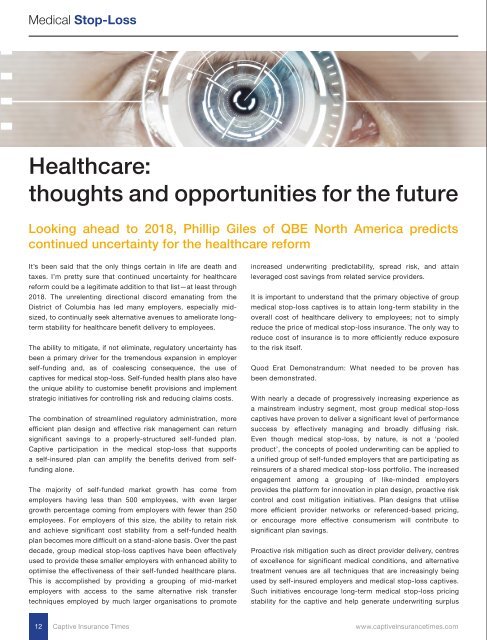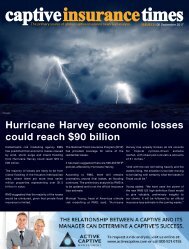Captive Insurance Times issue 136
Inside this issue of Captive Insurance Times, find out what industry experts predict the potential opportunities and challenges will be for the captive industry in 2018. Phillip Giles of QBE North America provides his thoughts on future opportunities for the healthcare sector. Also, history shows that it is difficult to predict when interest rates will change and when markets will rise or fall, which, according to Stephen Nedwicki of Comerica Bank, is even more reason to maintain a disciplined approach to your investments.
Inside this issue of Captive Insurance Times, find out what industry experts predict the potential opportunities and challenges will be for the captive industry in 2018.
Phillip Giles of QBE North America provides his thoughts on future opportunities for the healthcare sector.
Also, history shows that it is difficult to predict when interest rates will change and when markets will rise or fall, which, according to Stephen Nedwicki of Comerica Bank, is even more reason to maintain a disciplined approach to your investments.
Create successful ePaper yourself
Turn your PDF publications into a flip-book with our unique Google optimized e-Paper software.
Medical Stop-Loss<br />
Healthcare:<br />
thoughts and opportunities for the future<br />
Looking ahead to 2018, Phillip Giles of QBE North America predicts<br />
continued uncertainty for the healthcare reform<br />
It’s been said that the only things certain in life are death and<br />
taxes. I’m pretty sure that continued uncertainty for healthcare<br />
reform could be a legitimate addition to that list—at least through<br />
2018. The unrelenting directional discord emanating from the<br />
District of Columbia has led many employers, especially midsized,<br />
to continually seek alternative avenues to ameliorate longterm<br />
stability for healthcare benefit delivery to employees.<br />
The ability to mitigate, if not eliminate, regulatory uncertainty has<br />
been a primary driver for the tremendous expansion in employer<br />
self-funding and, as of coalescing consequence, the use of<br />
captives for medical stop-loss. Self-funded health plans also have<br />
the unique ability to customise benefit provisions and implement<br />
strategic initiatives for controlling risk and reducing claims costs.<br />
The combination of streamlined regulatory administration, more<br />
efficient plan design and effective risk management can return<br />
significant savings to a properly-structured self-funded plan.<br />
<strong>Captive</strong> participation in the medical stop-loss that supports<br />
a self-insured plan can amplify the benefits derived from selffunding<br />
alone.<br />
The majority of self-funded market growth has come from<br />
employers having less than 500 employees, with even larger<br />
growth percentage coming from employers with fewer than 250<br />
employees. For employers of this size, the ability to retain risk<br />
and achieve significant cost stability from a self-funded health<br />
plan becomes more difficult on a stand-alone basis. Over the past<br />
decade, group medical stop-loss captives have been effectively<br />
used to provide these smaller employers with enhanced ability to<br />
optimise the effectiveness of their self-funded healthcare plans.<br />
This is accomplished by providing a grouping of mid-market<br />
employers with access to the same alternative risk transfer<br />
techniques employed by much larger organisations to promote<br />
increased underwriting predictability, spread risk, and attain<br />
leveraged cost savings from related service providers.<br />
It is important to understand that the primary objective of group<br />
medical stop-loss captives is to attain long-term stability in the<br />
overall cost of healthcare delivery to employees; not to simply<br />
reduce the price of medical stop-loss insurance. The only way to<br />
reduce cost of insurance is to more efficiently reduce exposure<br />
to the risk itself.<br />
Quod Erat Demonstrandum: What needed to be proven has<br />
been demonstrated.<br />
With nearly a decade of progressively increasing experience as<br />
a mainstream industry segment, most group medical stop-loss<br />
captives have proven to deliver a significant level of performance<br />
success by effectively managing and broadly diffusing risk.<br />
Even though medical stop-loss, by nature, is not a ‘pooled<br />
product’, the concepts of pooled underwriting can be applied to<br />
a unified group of self-funded employers that are participating as<br />
reinsurers of a shared medical stop-loss portfolio. The increased<br />
engagement among a grouping of like-minded employers<br />
provides the platform for innovation in plan design, proactive risk<br />
control and cost mitigation initiatives. Plan designs that utilise<br />
more efficient provider networks or referenced-based pricing,<br />
or encourage more effective consumerism will contribute to<br />
significant plan savings.<br />
Proactive risk mitigation such as direct provider delivery, centres<br />
of excellence for significant medical conditions, and alternative<br />
treatment venues are all techniques that are increasingly being<br />
used by self-insured employers and medical stop-loss captives.<br />
Such initiatives encourage long-term medical stop-loss pricing<br />
stability for the captive and help generate underwriting surplus<br />
12 <strong>Captive</strong> <strong>Insurance</strong> <strong>Times</strong> www.captiveinsurancetimes.com

















